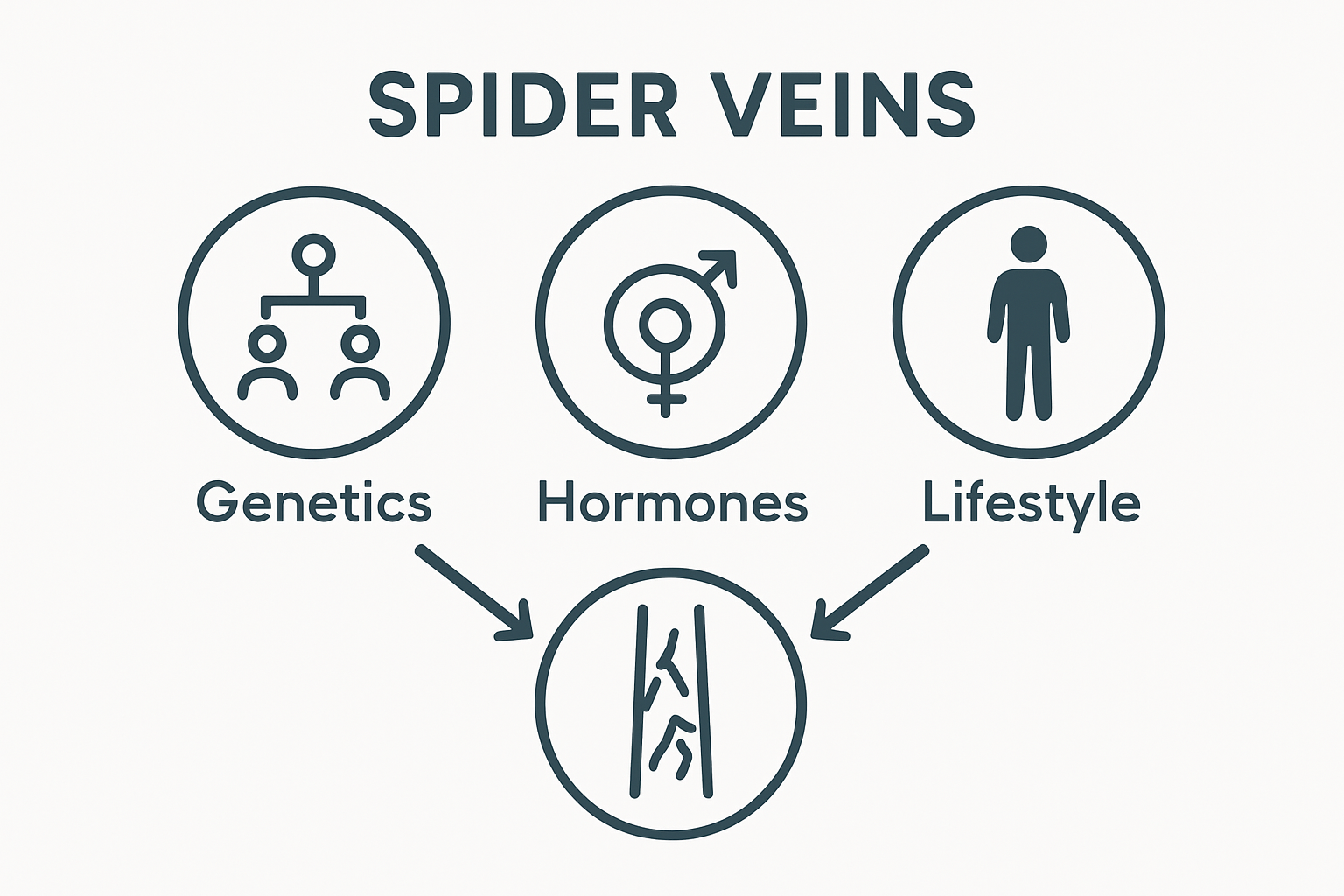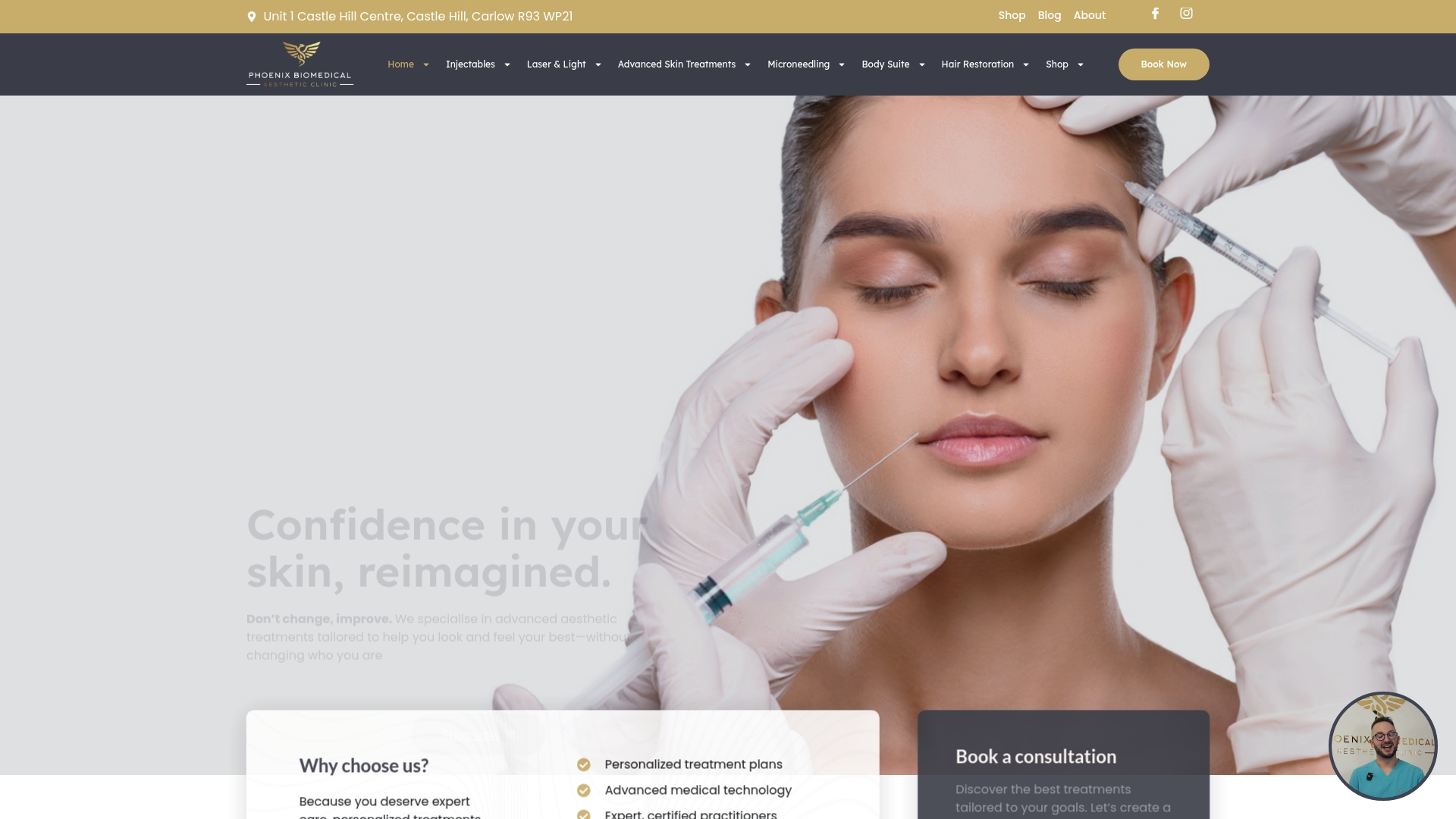Understanding What are Spider Veins and Their Impact
Spider veins show up as delicate red, blue, or purple lines that many try to cover up. Shockingly, nearly half of all women will develop spider veins at some point in their lives. Many think these are just a passing nuisance, but they can actually tell us quite a bit about what’s really happening with your circulation beneath the skin.
Table of Contents
- Defining Spider Veins: What Are They?
- The Importance Of Understanding Spider Veins
- Causes And Risk Factors For Spider Veins
- How Spider Veins Develop And Function
- Exploring Treatments And Management Options
Quick Summary
| Takeaway | Explanation |
|---|---|
| Spider veins indicate vascular health issues | They can signal underlying circulatory problems, not just cosmetic concerns. |
| Genetic and hormonal factors contribute significantly | Family history and hormonal changes increase the likelihood of developing spider veins. |
| Prolonged standing or sitting worsens spider veins | These lifestyle habits place extra pressure on blood vessels, leading to dilation. |
| Sclerotherapy is a leading treatment method | This minimally invasive option effectively reduces the visibility of spider veins. |
| Lifestyle changes can prevent progression | Regular exercise, maintaining a healthy weight, and using compression stockings support vascular health. |
Defining Spider Veins: What Are They?
Spider veins represent a common vascular condition characterised by small, damaged blood vessels that become visible through the skin’s surface. These delicate, web-like networks typically appear as thin, branching lines in shades of red, blue, or purple, most frequently emerging on the legs and face.
The Anatomical Perspective
From a medical standpoint, spider veins are technically known as telangiectasias – miniature dilated blood vessels located just beneath the skin’s surface. Unlike larger varicose veins, these are significantly smaller and generally do not cause physical discomfort. According to Mayo Clinic, spider veins develop when tiny blood vessel walls become weakened and expanded, creating visible networks that resemble spider webs or tree branches.
Below is a comparison table outlining the key differences between spider veins and varicose veins, based on characteristics mentioned in the article.
| Feature | Spider Veins | Varicose Veins |
|---|---|---|
| Medical Term | Telangiectasias | Varicosities |
| Appearance | Fine, web-like lines (red, blue, purple) | Bulging, twisted, larger veins |
| Diameter | Typically less than 1mm | Larger than 3mm |
| Usual Location | Legs, face, and ankles | Legs |
| Symptoms | Usually painless, cosmetic concern | Can cause pain, heaviness, discomfort |
| Significance | Often cosmetic, may reflect health issues | Indicate venous insufficiency |
| Treatment Focus | Aesthetic and preventive | Medical and preventive |
Key characteristics of spider veins include:
- Typically less than 1mm in diameter
- Flat or slightly raised against the skin
- Commonly occurring on legs, face, and ankles
- Usually painless and primarily a cosmetic concern
Underlying Causes and Risk Factors
Multiple factors contribute to the development of spider veins. Genetic predisposition plays a significant role, with individuals often inheriting a tendency towards these vascular irregularities. Hormonal changes, particularly during pregnancy, menopause, or while taking hormone replacement therapy, can trigger their appearance. Additional risk factors include:
- Age progression
- Prolonged standing or sitting
Environmental and lifestyle influences such as sun exposure, obesity, and lack of physical movement can also accelerate spider vein formation. National Institutes of Health research suggests that while spider veins are generally harmless, understanding their origins can help individuals manage and potentially prevent their progression.
The Importance of Understanding Spider Veins
While spider veins are often perceived as merely a cosmetic concern, understanding their deeper implications is crucial for maintaining overall vascular health and addressing potential underlying medical conditions. These intricate vascular networks provide valuable insights into an individual’s circulatory system and can serve as early warning signs of more complex health issues.
Beyond Aesthetic Considerations
Contrary to popular belief, spider veins are not just a superficial skin problem. These tiny dilated blood vessels can indicate significant circulatory challenges and potential venous insufficiency. According to Mayo Clinic, understanding spider veins can help healthcare professionals assess an individual’s overall vascular health and potential risk factors for more serious conditions.
Key medical insights provided by spider veins include:
- Early indicators of potential circulatory issues
- Reflection of hormonal and genetic predispositions
- Potential markers of underlying metabolic changes
- Signals of potential pressure variations in blood vessels
Health Monitoring and Prevention
Recognizing spider veins as more than a cosmetic issue enables proactive health management. These visible vascular changes can prompt individuals to evaluate their lifestyle, genetic risks, and potential preventative measures.
 Monitoring spider vein development can help in:
Monitoring spider vein development can help in:
- Identifying potential circulatory system weaknesses
- Understanding personal risk factors for venous disorders
- Motivating lifestyle modifications to support vascular health
By comprehensively understanding spider veins, individuals can transform what appears to be a simple aesthetic concern into an opportunity for informed health monitoring and potential early intervention. National Institutes of Health research emphasises the importance of viewing these vascular changes as potential indicators of broader health dynamics, encouraging a more holistic approach to personal healthcare.
Causes and Risk Factors for Spider Veins
Spider veins emerge through a complex interplay of physiological and environmental factors, representing a nuanced manifestation of underlying vascular health and individual genetic predispositions. Understanding these intricate mechanisms helps individuals comprehend their personal risk profile and potential preventative strategies.

Genetic and Hormonal Influences
Genetic inheritance plays a crucial role in spider vein development, with familial patterns significantly increasing an individual’s likelihood of experiencing these vascular irregularities. Hormonal fluctuations contribute substantially to their formation, particularly during periods of significant physiological change. According to Mayo Clinic, hormonal shifts during pregnancy, menopause, and hormone replacement therapy can dramatically impact blood vessel elasticity and pressure.
Key genetic and hormonal risk factors include:
- Direct family history of spider veins
- Inherited weakness in blood vessel walls
- Hormonal contraceptive use
- Pregnancy and associated hormonal changes
- Menopause and related hormonal transitions
Lifestyle and Environmental Triggers
Beyond genetic predispositions, numerous lifestyle and environmental factors significantly influence spider vein development. Prolonged periods of standing or sitting, lack of physical movement, and excessive body weight can create sustained pressure on blood vessels, leading to their eventual dilation and visibility.
Critical lifestyle risk factors encompass:
- Occupations requiring extended standing
- Sedentary work environments
- Obesity and increased body mass
- Limited physical activity
- Excessive sun exposure
Additionally, age represents a substantial contributor to spider vein formation. As individuals progress through different life stages, blood vessel walls naturally lose elasticity, becoming more susceptible to dilation and damage. National Institutes of Health research highlights that while these vascular changes are often inevitable, understanding their mechanisms empowers individuals to implement preventative strategies and maintain optimal circulatory health.
This table summarises the causes and risk factors contributing to spider vein development, as described throughout this section.
| Category | Examples and Details |
|---|---|
| Genetic Factors | Family history, inherited weakness in blood vessel walls |
| Hormonal Factors | Pregnancy, menopause, hormonal contraceptives, hormone therapy |
| Lifestyle Factors | Prolonged standing, sedentary lifestyle, obesity, limited activity |
| Environmental | Excessive sun exposure |
| Age | Vessel wall elasticity decreases over time |
How Spider Veins Develop and Function
Spider veins represent a complex vascular phenomenon arising from intricate physiological changes within the body’s circulatory system. Understanding their development requires exploring the nuanced interactions between blood vessels, surrounding tissues, and various biological mechanisms that contribute to their formation.
Vascular Mechanism and Blood Flow Dynamics
Blood vessel integrity plays a critical role in spider vein development. These delicate networks emerge when tiny blood vessels become weakened and dilated, causing them to become visible through the skin’s surface. According to Mayo Clinic, the process involves complex interactions between venous pressure, vessel wall elasticity, and internal valve functionality.
Key physiological mechanisms involved include:
- Breakdown of vessel wall structural integrity
- Increased venous pressure within small blood vessels
- Compromised valve function preventing proper blood backflow
- Gradual vessel dilation and expansion
- Reduced elasticity of vessel walls
Progression and Visibility Factors
The transformation from healthy blood vessels to visible spider veins occurs through a gradual process of structural deterioration. Microscopic changes in vessel walls create conditions that lead to their eventual enlargement and appearance beneath the skin. Factors influencing their progression include hormonal fluctuations, genetic predispositions, and cumulative environmental stressors.
Significant progression indicators encompass:
- Increasing vessel diameter
- Reduced blood vessel wall strength
- Changes in local blood circulation patterns
- Accumulation of metabolic waste products
- Decreased vessel elasticity with age
National Institutes of Health research emphasises that spider vein development is not merely a surface-level phenomenon but a complex interplay of biological processes reflecting broader vascular health and individual physiological characteristics.
Exploring Treatments and Management Options
Addressing spider veins involves a comprehensive approach that combines medical interventions, lifestyle modifications, and preventative strategies. Understanding the available treatment options empowers individuals to make informed decisions about managing these visible vascular networks and improving their overall circulatory health.
Primary treatment options include:
- Sclerotherapy injection treatments
- Laser vein removal procedures
- Radiofrequency ablation techniques
- Microsclerotherapy for smaller spider veins
- Endovenous laser therapy
Complementary Management Strategies
Beyond direct medical interventions, comprehensive spider vein management encompasses lifestyle modifications and preventative approaches. Individuals can significantly impact their vascular health through targeted strategies that reduce pressure and support blood vessel integrity.
Effective complementary management techniques involve:
- Regular physical exercise
- Wearing compression stockings
- Maintaining a healthy body weight
- Elevating legs during rest periods
- Avoiding prolonged standing or sitting
National Institutes of Health research emphasises that successful spider vein management requires a holistic approach, combining medical treatments with proactive lifestyle choices to minimise their progression and appearance.
Experience Safe and Effective Spider Vein Solutions with Phoenix Biomedical.ie
If the appearance or discomfort of spider veins has left you feeling self-conscious or worried about your vascular health, you are not alone. This article explored the impact of spider veins from both a cosmetic and a medical perspective, highlighting concerns such as visible vein networks, genetic and lifestyle risk factors, and the desire for lasting results. At Phoenix Biomedical.ie, we understand these concerns and offer advanced non-invasive treatments designed to restore clear, healthy skin and support your confidence.

Trust our experienced dermatology and aesthetic professionals to develop a personalised plan using clinically proven methods like laser treatments and skin boosters that target spider veins precisely. Book your private consultation today at Phoenix Biomedical.ie to discover how simple, safe and effective spider vein management can be. Take the first step now toward smoother, healthier skin — appointments fill quickly and expert help is just a click away.
Frequently Asked Questions
What are spider veins?
Spider veins are small, damaged blood vessels that become visible through the skin’s surface, appearing as thin, web-like networks in shades of red, blue, or purple. They typically occur on the legs and face.
What causes spider veins to develop?
Spider veins can develop due to a combination of genetic predisposition, hormonal changes, prolonged standing or sitting, obesity, and environmental factors like sun exposure.
Are spider veins a serious health concern?
While spider veins are generally considered a cosmetic issue, they can indicate underlying circulatory problems. Understanding their presence can help assess overall vascular health and potential risks for more serious conditions.
How can spider veins be treated or managed?
Treatment options include sclerotherapy, laser treatments, and lifestyle changes such as regular exercise, maintaining a healthy weight, and wearing compression stockings to reduce pressure on blood vessels.
